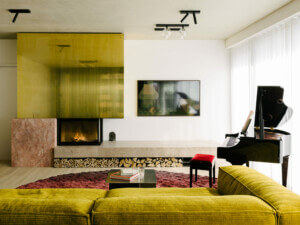Though Casa Gracia is the renovation of a 1,400-square-foot apartment in a 1970s building in Madrid, its organization bears the influence of many precedents: the urban grid of Barcelona, with its distinctive Avenida Diagonal; the ornate double doors of Luigi Caccia Dominioni; the served and servant spaces of Louis Kahn’s later plans; and the recent Spanish experiments by like MAIO’s 22 Dwellings Housing Block in Barcelona. The resulting spatial sequences of HANGHAR’s project upend expectations about how rooms are used, allowing for new ways to inhabit the indifferent apartment interior.
In plan, the apartment is mirrored diagonally around an interior octagon, where a central wet core—comprising bathrooms inside the shape and a small kitchen along two of its outer walls—are situated. On the octagon’s orthogonal sides, small squares of spaces are used either as vestibules or closets. Then, walls are run from those corners at a 45-degree angle into the perimeter of the apartment, making 5-, 6-, or 7-sided rooms. Aside from the bathrooms, there are no internal doors, and mirrors also further confuse the residence’s internal geometry.
Read more on aninteriormag.com.











